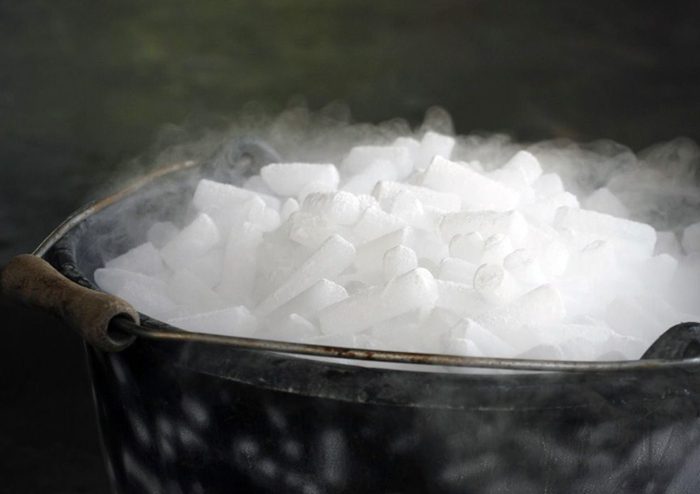Dry Ice Production on Mars: Dry Ice Could Help Provide Energy To Human Colonies On Mars
Dry ice, solid carbon dioxide (CO2), is a potential energy source for future human colonies on Mars. The Martian atmosphere is primarily composed of CO2, making it a readily available resource for dry ice production.
Challenges of Extracting and Processing Carbon Dioxide
Extracting and processing CO2 from the Martian atmosphere presents several challenges. The atmospheric pressure on Mars is significantly lower than Earth’s, requiring specialized equipment for efficient CO2 capture. Additionally, the Martian atmosphere is very cold, which could hinder the efficiency of CO2 capture and processing systems.
Challenges
- Low Atmospheric Pressure: The thin Martian atmosphere, with a pressure about 100 times lower than Earth’s, makes it difficult to efficiently capture CO2. Special equipment designed to operate at low pressure is required.
- Low Temperature: The average temperature on Mars is -63°C, which could affect the efficiency of CO2 capture and processing systems. Maintaining optimal operating temperatures for these systems would require significant energy input.
- Dust and Atmospheric Composition: The Martian atmosphere contains dust and other impurities that could contaminate CO2 capture and processing equipment. This would require additional filtration and purification steps, adding complexity and energy consumption.
Energy Requirements and Technological Advancements
Producing dry ice on Mars requires substantial energy input for CO2 capture, processing, and conversion into solid form. This energy could be obtained from solar panels, nuclear reactors, or other potential sources.
Energy Requirements and Technological Advancements
- Efficient CO2 Capture Systems: Developing efficient CO2 capture systems capable of operating in the thin Martian atmosphere is crucial. This could involve using advanced membrane technologies or cryogenic separation methods.
- Energy-Efficient Processing: The processing of captured CO2 into dry ice requires energy for compression and cooling. Optimizing these processes through technological advancements in energy-efficient refrigeration and compression technologies is vital.
- Sustainable Energy Sources: Reliable and sustainable energy sources are essential for dry ice production on Mars. This could include solar panels, nuclear reactors, or potentially harnessing Martian wind energy.
Dry Ice Energy Conversion Technologies
Harnessing the energy stored within dry ice (solid carbon dioxide) presents a promising avenue for sustaining human colonies on Mars. Dry ice, abundant on the Martian surface, offers a potential energy source that could be utilized to generate electricity and heat, crucial for human survival and infrastructure development.
Thermoelectric Generators
Thermoelectric generators (TEGs) offer a direct method for converting the thermal energy of dry ice into electricity. TEGs operate on the Seebeck effect, a phenomenon where a temperature difference across a semiconductor material creates an electrical voltage.
- In a TEG, one side of the semiconductor material is heated by the sublimation of dry ice, while the other side is kept at a lower temperature, creating a temperature gradient.
- This temperature difference drives the movement of electrons, generating a small electrical current.
- TEGs are solid-state devices, requiring no moving parts, making them reliable and well-suited for harsh Martian environments.
The efficiency of TEGs is dependent on the temperature difference across the device and the material properties of the semiconductor. While TEGs have proven effective in applications like waste heat recovery, their efficiency in converting the energy from dry ice sublimation remains a challenge. However, advancements in material science and design are continuously improving the performance of TEGs, paving the way for their potential application in Martian energy systems.
Sublimation Engines
Sublimation engines utilize the direct phase change of dry ice from solid to gas to generate mechanical work. These engines operate on the principle of expanding gas, similar to conventional combustion engines, but instead of burning fuel, they use the sublimation of dry ice.
- Dry ice is introduced into a closed chamber, where it sublimates, increasing the pressure within the chamber.
- The expanding gas drives a piston or turbine, generating mechanical energy.
- This mechanical energy can then be used to power generators, pumps, or other machinery.
Sublimation engines offer a potentially more efficient way to convert the energy stored in dry ice compared to TEGs. However, they present engineering challenges, such as managing the high pressures and temperatures generated during sublimation and ensuring the efficient transfer of energy to the working fluid.
Efficiency and Practicality in the Martian Environment, Dry ice could help provide energy to human colonies on mars
The efficiency and practicality of dry ice energy conversion technologies in the Martian environment are influenced by several factors:
- The abundance and accessibility of dry ice on the Martian surface.
- The low atmospheric pressure and temperature on Mars, which can affect the sublimation rate of dry ice.
- The need for robust and reliable energy systems that can withstand the harsh Martian conditions.
While both TEGs and sublimation engines offer promising approaches to harnessing dry ice energy, their practical implementation on Mars requires further research and development. Optimization of these technologies, considering the specific conditions on Mars, is crucial for ensuring their efficiency and reliability.
Applications of Dry Ice Energy in Martian Colonies
Dry ice, solid carbon dioxide, is a potential energy source for Martian colonies, offering a sustainable and readily available alternative to traditional energy sources. Its unique properties make it an ideal candidate for powering various aspects of Martian life, from habitats to transportation.
Powering Habitats
Dry ice can be used to power habitats in a variety of ways. Its sublimation process, the transition from solid to gas, can be harnessed to generate electricity using a thermoelectric generator. This process involves converting heat energy from the sublimating dry ice into electrical energy. Additionally, dry ice can be used for heating and cooling habitats. Its sublimation absorbs heat from the surrounding environment, providing a cooling effect. Conversely, the heat released during the sublimation process can be used for heating purposes.
Greenhouses
Dry ice can be used to provide a controlled environment for growing plants in Martian greenhouses. Its sublimation can be used to regulate temperature and humidity levels within the greenhouse, creating optimal conditions for plant growth. Additionally, the carbon dioxide released during sublimation can be used as a natural fertilizer for plants, enhancing their growth and productivity.
Transportation Systems
Dry ice can power Martian transportation systems through its sublimation. The gas released during sublimation can be used to propel vehicles or generate electricity for electric vehicles. Furthermore, dry ice can be used to create thrust for rockets and spacecraft, providing a sustainable and efficient method for Martian transportation.
Benefits of Dry Ice Energy
Dry ice energy offers several advantages for Martian colonies:
- Sustainability: Dry ice is a readily available resource on Mars, ensuring a sustainable energy source for future colonies.
- Self-sufficiency: Dry ice energy promotes self-sufficiency, reducing the need for external energy supplies from Earth.
- Clean Energy: Dry ice is a clean energy source, producing minimal emissions and reducing the carbon footprint of Martian settlements.
- Versatile Applications: Dry ice energy can be used for a wide range of applications, including powering habitats, greenhouses, and transportation systems.
| Application | Benefits |
|---|---|
| Powering Habitats | Sustainable, clean, and versatile energy source for heating, cooling, and electricity generation. |
| Greenhouses | Regulates temperature and humidity, provides natural fertilizer for plants, and enhances plant growth. |
| Transportation Systems | Provides propulsion for vehicles, generates electricity for electric vehicles, and offers a sustainable and efficient method for Martian transportation. |
Challenges and Future Directions
While dry ice holds promise as a Martian energy source, several challenges must be addressed before it becomes a viable reality. This section will explore the potential environmental impact, safety concerns, and scalability of dry ice energy technology. It will also delve into future research directions aimed at enhancing its efficiency and practicality.
Environmental Impact
The production and utilization of dry ice on Mars could potentially have both positive and negative environmental impacts. For instance, the sublimation of dry ice releases carbon dioxide into the Martian atmosphere. While this could contribute to a thicker atmosphere, which could potentially lead to a warmer planet, it could also contribute to the greenhouse effect and further exacerbate global warming. Therefore, careful consideration must be given to the overall impact of dry ice energy on the Martian environment.
Safety Concerns
The handling and storage of dry ice present significant safety concerns. Dry ice is extremely cold (-78.5°C or -109.3°F) and can cause severe frostbite if handled improperly. It also sublimates into carbon dioxide gas, which can displace oxygen and lead to asphyxiation in enclosed spaces. Therefore, robust safety protocols and infrastructure must be developed to ensure the safe production, storage, and utilization of dry ice on Mars.
Scalability
Scaling up dry ice production and energy conversion technologies to meet the energy demands of a Martian colony is a significant challenge. The current technologies available for producing and converting dry ice energy are not yet sufficiently efficient or scalable to support large-scale energy production on Mars. Significant advancements in technology are needed to overcome these limitations.
Future Research Directions
To overcome these challenges and make dry ice energy a practical reality on Mars, future research efforts should focus on the following areas:
- Developing more efficient and scalable methods for producing dry ice from Martian resources. This could involve exploring alternative methods for carbon dioxide capture and purification, as well as optimizing the efficiency of current dry ice production technologies.
- Improving the efficiency of dry ice energy conversion technologies. This could involve developing new and innovative technologies for converting the thermal energy of sublimating dry ice into electricity, or improving the efficiency of existing technologies.
- Developing robust safety protocols and infrastructure for handling and storing dry ice on Mars. This could involve designing specialized equipment and facilities for safe dry ice production, storage, and transportation.
- Conducting thorough environmental impact assessments to ensure that dry ice energy production and utilization do not negatively impact the Martian environment. This could involve studying the long-term effects of carbon dioxide release on the Martian atmosphere and developing strategies to mitigate any negative impacts.
Potential Innovations
Several potential innovations could enhance dry ice production, conversion, and utilization on Mars:
- Development of a closed-loop system for dry ice production and utilization that minimizes carbon dioxide release into the Martian atmosphere.
- Development of new and efficient thermoelectric generators that can directly convert the thermal energy of sublimating dry ice into electricity.
- Development of advanced materials and technologies for safe and efficient dry ice storage and transportation.
- Utilization of artificial intelligence and machine learning to optimize dry ice production and energy conversion processes.
Dry ice could help provide energy to human colonies on mars – While there are challenges to overcome, such as developing efficient methods for extracting and processing carbon dioxide, the potential of dry ice as a power source for Martian colonies is undeniable. Imagine a future where Martian settlers rely on the planet’s natural resources to power their homes, grow their food, and even travel across the red landscape. It’s a future that might be closer than we think, and it’s a future powered by dry ice.
Imagine a future where humans are colonizing Mars, and dry ice, a solid form of carbon dioxide, is the key to powering our settlements. It’s a pretty wild concept, but it’s a real possibility! While we’re waiting for that to become reality, we can at least get excited about the news that HBO and Cinemax are landing on PlayStation Vue soon, giving us even more entertainment options.
But back to Mars, the idea of using dry ice for energy is pretty fascinating, right? It’s just one of the many innovations that could help us establish a sustainable human presence on the Red Planet.
 Standi Techno News
Standi Techno News

